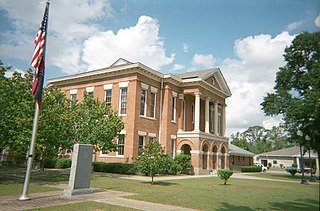Related Research Articles

Tippah County is a county located on the northern border of the U.S. state of Mississippi. As of the 2020 census, the population was 21,815. Its county seat is Ripley. The name "Tippah" is derived from a Chickasaw language word meaning "cut off." It was taken from the creek of the same name that flows across much of the original county from northeast to southwest before emptying into the Tallahatchie River. The creek probably was so named because it, and the ridges on either side, "cut off" the western part of the region from the eastern portion.

Perry County is a county located in the U.S. state of Mississippi. As of the 2020 census, the population was 11,511. The county seat is New Augusta. The county is named after the War of 1812 naval hero, Oliver Hazard Perry.

The Tennessee–Tombigbee Waterway is a 234-mile (377 km) artificial U.S. waterway built in the 20th century from the Tennessee River to the junction of the Black Warrior-Tombigbee River system near Demopolis, Alabama. The Tennessee–Tombigbee Waterway links commercial navigation from the nation's midsection to the Gulf of Mexico. The major features of the waterway are 234 miles (377 km) of navigation channels, a 175-foot-deep (53 m) cut between the watersheds of the Tombigbee and Tennessee rivers, and ten locks and dams. The locks are 9 by 110 by 600 feet, the same dimension as those on the Mississippi above Lock and Dam 26 at Alton, Illinois. Under construction for 12 years by the U.S. Army Corps of Engineers, the Tennessee–Tombigbee Waterway was completed in December 1984 at a total cost of nearly $2 billion.

Town Creek, also known as Old Town Creek or West Fork Tombigbee River, is a tributary stream of the Tombigbee River. Its mouth is approximately two miles east of Amory in northeast Mississippi.
Bogue Flower is a stream in the U.S. state of Mississippi. It is a tributary to Eucutta Creek.
Bogue Homo is a stream in the U.S. state of Mississippi. It is a tributary to the Chickasawhay River.
Bolingchessa Creek is a stream in the U.S. state of Mississippi. It is a tributary to Hanging Moss Creek.
Chiwapa Creek is a stream in the U.S. state of Mississippi. It is a tributary to Town Creek.
Coonewah Creek is a stream in the U.S. state of Mississippi. It is a tributary to Town Creek.
Eucutta Creek is a stream in the U.S. state of Mississippi. It is a tributary to the Chickasawhay River.Eucutta is a name derived from the Choctaw language, most likely meaning "large pond".
Eucutta is an unincorporated community in Wayne County, in the U.S. state of Mississippi.
Hollicar Creek is a stream in the U.S. state of Mississippi. It is a tributary to Shubuta Creek.
Mingo Creek is a stream in the U.S. state of Mississippi.
Okatuppa Creek is a stream in Choctaw County in the U.S. state of Alabama.
Big Oktibee Creek is a stream in the U.S. state of Mississippi.
Okwakee Creek is a stream in the U.S. states of Alabama and Mississippi.
Sea Warrior Creek is a stream in the U.S. state of Alabama.
Tallabogue Creek is a stream in the U.S. state of Mississippi. It is a tributary to the Chickasawhay River.
Tampa Creek is a stream in the U.S. state of Mississippi.
Tibbee Creek is a stream in the U.S. state of Mississippi.
References
- 1 2 U.S. Geological Survey Geographic Names Information System: Coonipper Creek
- ↑ Baca, Keith A. (2007). Native American Place Names in Mississippi. University Press of Mississippi. p. 32. ISBN 978-1-60473-483-6.
31°56′21″N88°41′11″W / 31.9390415°N 88.6864301°W